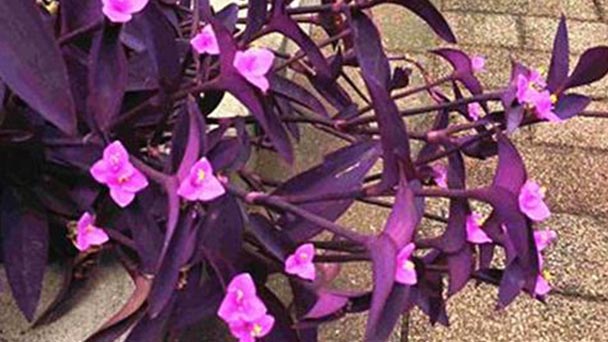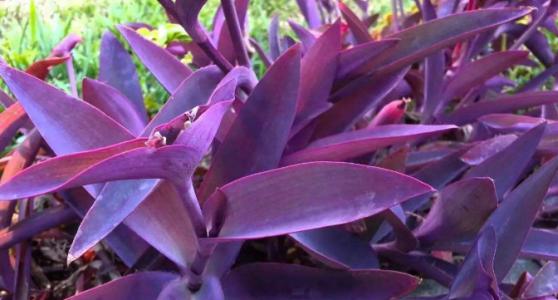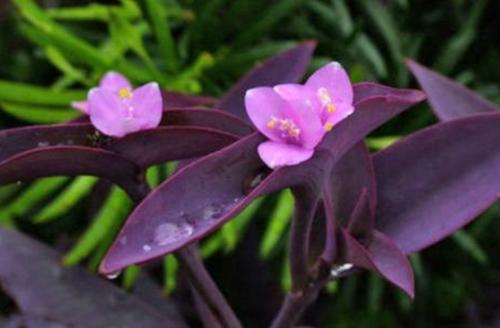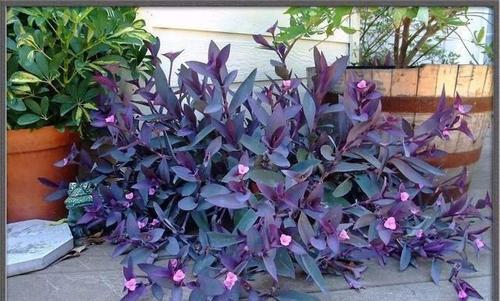Purple Heart Plant (Tradescantia Pallida) Profile: Info, Care & Propagation Guide
Written by Maggie
Dec 07 2021

Purple heart plant (Tradescantia pallida) is a perennial herbaceous plant of Anatidaceae. The Purple heart is 20-30 cm tall. The leaves are lanceolate, slightly curled, purplish red, and covered with fine villi. Stem is purplish brown, initial upright, elongated after a semi - tendrils, was creeping. Spring and summer flowering, peach color, there are varieties, white stripes on the leaves. The flowers are small and white and open in summer and autumn. The amount of flowers is larger under the condition of sufficient sunshine.
Purple heart plant is a perennial herb, the whole plant is dark purple; The stem and leaves are thick and brittle, easily broken.Leaves alternate, oblong-lanceolate;Leaf sheaths with lashes at the margin and mouth of the sheaths; Leaves are often covered with white wax. Flowers at the apex of each branch, protected by leaflike bracts, petals three, purplish red, stamens 6, filaments hairy.
Purple heart plant is native to Mexico, cultivated on campus.
Purple Heart Plant Picture

Purple Heart Plant info
| Botanical Name | Tradescantia pallida |
| Common Names | Purple-heart plant, wandering Jew, purple secretia |
| Plant Type | Perennial |
| Sun | Full sun |
| Hardiness Zones | 7-10, USA |
| Flower color | Purple |
| Native Area | Mexico |
| Mature size | 14 in. tall |
Characteristics of Purple Heart Plant
Perennial scattered herbaceous, Purple heart plant is 20 ~ 50 cm high.
Stem of purple heart plant is more branching, with fleshy, purplish red, lower prostate, common fibrous roots on the node, the upper part nearly upright. Leaves are alternate, lanceolate, 6 ~ 13 cm long, 6 ~ 10 mm wide, apex acuminate, entire margin, the base of the stem and into the sheath, the mouth of the sheath has long white eyelashes, dark green above, green purple edge, purple below.
Flowers of Purple heart plant are densely on bifurcate stalks, with linear-lanceolate bracts, ca. 7 cm long; Purple heart plant has 3 sepals, green, ovoid, persistent; Purple heart plant has 4 petals, blue-purple, broadly ovate; Stamens 6,2 hairs, 3 vestigial, 1 filament short and slender, without anthers; Pistil 1, ovary ovate, 3-loculed, style filiform and long, stigma capitate.
Capsule elliptic, with 3 raised edges.
Seeds are triangulated semicircular, brown. Flowering in summer and autumn.
Habits of Purple Heart Plant
Purple heart plant likes warm, moist, not cold, avoid sun exposure, like half shade. It has strong adaptability to drought and is suitable for fertile and moist loam soil.
Purple heart plant should be used in a white, blue or other pot. During the growth period, except mid-summer June to September around noon to shade, other seasons should be given sufficient light. Keep enough light, its color can be bright, long time overshade, the color will be dim, and the internode becomes long, branches and tendrils are not quite, lack of vitality. In addition, fat can also cause futility, 1-2 times a month fertilizer water can be cake. Watering to not do not water. In summer, when the weather is dry, spray water on the plants to increase humidity and make them more viable.
Winter basin soil slightly wet can be, in March of the next year, to grow weak and messy plants for a whole cut, in order to promote new branches.
Purple heart plant can be taken in the growth season in water, soil cuttings are easy to survive.
How to Care for Purple Heart Plant
Purple Heart Plant Himidity Care
Purple heart plant likes a humid climate environment, the relative temperature of air in the growth environment is required to be 60 ~ 75%.
Purple Heart Plant Temperature Care
The optimum growth temperature is 18℃ ~ 30℃, avoid cold frost, overwintering temperature needs to be kept above 10℃, in winter the temperature drops below 4℃ into hibernation state. If the ambient temperature is close to 0℃, Purple heart plant will die due to frostbite.
In the summer:
Strengthen the air convection, so that the body temperature can be emitted;
Put in the half shade, or give it shade 50%;
Spray it appropriately 2 ~ 3 times a day.
In the winter:
1. Move to a bright place for Purple Heart Plant Indoor Care;
2. In the outdoor, available film to wrap it up for winter, but every two days in the noon when the temperature is higher to uncover the film to let it breathe;
Read More:
Purple Heart Plant Indoor Care
Purple Heart Plant Light Requirements
Purple heart plant is afraid of strong light, need to be placed in half shade conservation, or give it shade 70%. Put in the indoor maintenance, as far as possible in a bright place, and every one or two months to move to the outdoor half shade or shade maintenance for a month, in order to allow its accumulation of nutrients, restore growth. (Find more Vine Plants Indoor here.)
Watering Purple Heart Plant
Purple heart plant requires more fertilizer and water, but it is most afraid of indiscriminate fertilization, concentrated fertilizer and partial application of nitrogen, phosphorus and potassium fertilizer. It requires to follow the fertilization (water) principle of "frequent application of light fertilizer, less amount and more times, and complete nutrition" :
Three seasons: spring, summer, autumn three season is its growth season, water management, in accordance with the "flower", "flower" - water - "flower", "flower", the order of the water cycle (at the very least to ensure that the "flower" twice a week), interval period is about: outdoor maintenance of 1 ~ 4 days, sunny days or high temperature during every cycle short, rainy day or during the low temperature cycle longer insulation or not watering; Put in the indoor maintenance of 2 ~ 6 days, watering time as far as possible arranged in the morning when the temperature is low.Water in the summer when the temperature is low in the morning or evening, and spray the plants often.
Purple Heart Plant Care in Winter
During the purple heart plant dormant period in winter, the main task is to control fertilizer and water. Fertilization and water management should follow the sequence of "Huabao" -- clear water -- clear water -- "Huabao" -- clear water -- clean water. The interval period is about 7 ~ 10 days.
Pruning Purple Heart Plant
Purple heart plants grow long stems, and due to their fast growth rate, they can become leggy and spindly very quickly. You'll want to prune them during the warmer months when all of the flowers have bloomed. Be sure to use sharp scissors and gloves. Aim to take off the top half of the stems that have become overgrown.
Repotting Purple Heart Plant
Since Purple heart plants generally don't grow to be that large, they are commonly kept as houseplants. They won't require frequent repotting but will need to be transferred to a new container if the roots begin to push through the drainage holes located on the underside of the pot. This will typically occur during spring due to their tendency to spread out during the growing season.

Purple Heart Plant Propagation
Purple heart plant should be used in a white, blue or other pot. During the growth period, except mid-summer June to September around noon to shade, other seasons should be given sufficient light. Keep enough light, its color can be bright, long time overshade, the color will be dim, and the internode becomes long, branches and tendrils are not quite, lack of vitality. In addition, fat can also cause futility, 1-2 times a month fertilizer water can be cake. Watering to not do not water. In summer, when the weather is dry, spray water on the plants to increase humidity and make them more viable.
Winter slightly pot soil wet can be, in March of the next year to grow weak and messy plants for a whole cut, in order to promote new branches.
Grasses can be taken in the growth season in water, soil cuttings are easy to survive.
The nutrient soil that uses cuttage namely or the material such as soil of river sand, mud carbon. Family cuttings are limited to the piece is difficult to get the ideal cutting substrate, it is recommended to use the cutting substrate as it has been prepared and disinfected; Medium-coarse river sand is fine, but rinse with clean water several times before use. Sea sand and saline areas of river sand are not used, they are not suitable for the growth of flowers and plants.
The branches of Purple heart plant used for cutting are called cuttings. Cut the stem into 5 to 8 cm long segments, each segment with more than three leaf nodes, also can be used as cuttings at the top.
Purple Heart Plant Insects & Diseases
No serious problems, although aphids and vine weevil are attracted, as well as scales and mealybugs. Outdoor plants can be munched on by caterpillars, slugs and snails.
Distribution of Purple Heart Plant
Purple Heart plant is native to Mexico and other places. It likes light and shade, likes humidity and is relatively drought-resistant. Purple heart plant has low requirements on soil and is slightly cold resistant.
Uses of Purple Heart Plant
Purple Heart broadcasts the weather
Purple Heart, a plant that grows in North America, has small flowers that are normally blue. When the air pollution is severe, its flowers turn pink, so local people judge the level of air pollution by the color of its bloom.
Medical uses
Purple heart plant can promote blood, stop bleeding, relieve snake venom. Purple heart plant can cure snake blisters, sores, snake bites, falls, rheumatism.

Read Next:
20 Popular Vine Plants Indoor To Grow
Latest Updated
- Benefits of Bugleweed - 7 Science-backed Health Benefits
- Bugleweed Dangers & Side Effects - Is It Poisonous?
- How to Plant Evergreen Trees - What You Should Know
- When to Plant Evergreens - Grow Guide for Evergreen Trees
- 12 Wonderful Evergreen Shrubs for Your Garden
- 12 Popular Evergreen Plants with Pictures for Beginners
- When And How To Prune A Lilac Bush Like a Pro
- How to Grow & Care for Lilac Vine (Hardenbergia Violacea)
- Japanese Lilac Tree (Syringa Reticulata) Care & Propagation Guide
- Shumard Oak Pros and Cons - What to Know
Popular Articles
- Winter maintenance of Antirrhinum Majus
- How to Grow Terminalia Mantaly Tree
- How to Grow and Care for Crossostephium Chinense
- How to grow Antirrhinum Majus in spring
- Peristeria Elata (Dove Orchid) Profile: Info & Care Guide
- Underwatered Snake Plant (Sansevieria Trifasciata) - Signs And How To Fix
- How to Care for Brazilian Jasmine Plant (Mandevilla Sanderi)
- How to Grow & Care for Graptopetalum Purple Delight in Summer
- Rosa Chinensis (China Rose): Plant Growing & Care Tips
- How to Care for Baby Sun Rose (Aptenia Cordifolia)